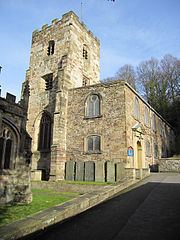Population 8,886 (2011 Census) Principal area Flintshire Sovereign state United Kingdom Local time Monday 9:09 PM Ceremonial county Clwyd | OS grid reference SJ185755 Country Wales Post town HOLYWELL Dialling code 01352 UK parliament constituency Delyn | |
 | ||
Weather 9°C, Wind SW at 14 km/h, 85% Humidity | ||
St winefride s well holywell flintshire north wales 28th february 2012
Holywell (Welsh: Treffynnon) is the fifth largest town in Flintshire, Wales. It lies to the west of the estuary of the River Dee.
Contents
- St winefride s well holywell flintshire north wales 28th february 2012
- Map of Holywell UK
- Holywell town branch railway trackbed a548 bridge greenfield wales
- History
- Demography
- Railways
- Geography
- Community
- Notable people
- References
Map of Holywell, UK
Holywell town branch railway trackbed a548 bridge greenfield wales
History
The market town of Holywell takes its name from the St Winefride's Well, a holy well surrounded by a chapel. The well has been known since at least the Roman period. It has been a site of Christian pilgrimage since about 660, dedicated to Saint Winefride who, according to legend, was beheaded there by Caradog who attempted to attack her. The well is one of the Seven Wonders of Wales and the town bills itself as The Lourdes of Wales. Many pilgrims from all over the world continue to visit Holywell and the Well.
From the 18th century, the town grew around the lead mining and cotton milling industries. The water supply from the mountains above the town, which flows continually and at a constant temperature, supplies the well and powered many factories in the Greenfield Valley. In addition to lead and cotton, copper production was of great importance. Thomas Williams, a lawyer from Anglesey built factories and smelteries for copper in Greenfield Valley, bringing the copper from Anglesey to St. Helens and then to Greenfield Valley where it was used to make many items for the slave trade. These items included manilas (copper bracelets), neptunes (large flat dishes to evaporate seawater to produce salt) and copper sheathing. The copper sheathing was used to cover the hulls of the wooden ships trading in the warmer Caribbean waters, giving rise to the expression 'copper bottomed investment', the sheathing was also applied to Royal Navy ships and was instrumental in Nelson's victories (two of these copper plates from HMS Victory are in Greenfield Valley Heritage Park museum). There was a railway station in Greenfield that was open between 1848 and 1966. Holywell Town station, at the head of a steeply-climbing branch from Holywell Junction, was closed in 1957.
The wealth generated from these industries led to the development of the town and the High Street still has many Georgian buildings. The Greenfield Valley is well known for the abundance of birds and butterflies and many enthusiasts visit to see the array of species. The Valley also has a number of conserved mills and structures from bygone ages and is the only place in Wales to have seven scheduled ancient monuments.
St James parish church is a grade II* listed building
Holywell hosted an unofficial National Eisteddfod event in 1869.
Demography
Administratively, Holywell town consists of three wards of the Flintshire County Council local authority. At the 2001 Census, the total population of the town was:
With the adjoining villages the population is over 15,000
Railways
Holywell Junction was on the North Wales Coast Line. The station is closed, and trains run fast through what remains of the station. The station building, by Francis Thompson for the Chester and Holyhead Railway (1848), is listed Grade II*. The LNWR branch line from here to Holywell Town, opened in 1912 and finally closed in 1957.
Geography
Holywell is split into four distinct areas: Pen-y-Maes, the Strand, the Holway and the town centre. The Holway, located on the west side of the town, is the largest of the residential areas of Holywell. The near-contiguous village of Greenfield is located to the north east of the town on the B5121 road.
Villages within the Holywell catchment area include: Bagillt, Brynford, Carmel, Gorsedd, Halkyn, Licswm, Lloc, Mostyn, Pantasaph, Pentre Halkyn, Rhes-y-Cae, Trelawnyd, Whitford and Ysceifiog. In addition there are other smaller scattered communities within this area. All of these are within a six-mile radius of Holywell. These villages are all connected to Holywell by a frequent bus service.
Community
The town centre contains many small businesses and national stores, serving not only the shopping needs of the people of the town itself, but also those of the surrounding villages within the town's natural catchment area. Part of the centre of the historic market town has been designated a conservation area.
The town contains a secondary school with over 500 pupils and a leisure centre, as well as four primary schools.
Holywell has a local football team, Holywell Town who play in the Welsh Alliance League.
The old cottage hospital was located in Pen-y-Maes until it closed. A new hospital has been built.
Although Holywell does not have a cricket team carrying the name of the town; a number of junior and senior cricketers from the area play for nearby village team Carmel & District Cricket Club whose ground is located a short distance from Holywell between the villages of Carmel and Lloc.
In 2007, a group of locals proposed a circular walk way, the "St Beuno's Circular Walk", joining all of the historical and religious locations of the town.
